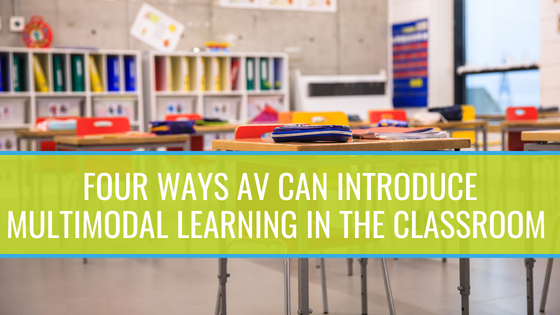Researchers and educators alike have realized that multimodal learning is effective at improving student engagement, information recall and test performance. We all have our learning preferences, which may include the following components:
- Audio
- Video
- Reading
- Writing
- Kinesthetic (physical)
We all learn in different ways using a combination of the above. A multimodal learning style recognizes this and incorporates as many channels of information as possible into each lesson. By doing so, teachers can reach a larger variety of students and improve their understanding of the lesson material.
AV technology is a multimodal lesson supporter, with solutions that add compelling audio, video, and tactile activities to the classroom. There are many to choose from, but four of the most popular include:
- Audio enhancement systems
- Interactive displays
- Augmented and virtual reality systems (AR/VR)
- Interactive activity spaces
Let’s take a closer look at each and where they fit best.
Audio Enhancement Immerses Students in Richer Sounds
Poor audio affects a large number of U.S. classrooms, which is suggested by data provided by the Department of Education's Mainstream Amplification Resource Room Study. The study found that enhancing audio levels in the classroom led to 40 percent fewer special education referrals.
The size of the classroom, the teacher's speaking volume, the room's acoustics and ambient noise can all have an effect on classroom audio quality. Students at the back may be outside of the teacher's effective speaking range, robbing those students of valuable audio-centric lesson material.
Audio enhancement solutions, including those provided by FrontRow and Audio Enhancement, are designed to lift the lecturer's voice and blanket classrooms with rich sound. These solutions are easy to integrate into a classroom and with the school's PA system.
With better in-class audio, students that require sound-reinforced learning will find it easier to keep pace with instruction and recall lesson content with greater accuracy.
Interactive Displays Provide Powerful Visuals and a Tactile Component
Like standard digital displays, interactive displays are excellent at teaching concepts visually. Interactive displays take the multimodal approach a step further, though, as they also appeal to the kinesthetic learner. This is valuable for most classrooms, as the most common learning approach for people is through kinesthetic teaching methods.
A study by VARK (visual, aural, read/write, kinesthetic) surveyed more than 237,500 people and found that kinesthetic learning was preferred by 90 percent of students, to some extent. Interactive displays bring this tactile element in the lesson through an interactive touchscreen. With an interactive display like the Clevertouch or ActivPanel, students can use touch gestures to solve quizzes, label maps, compete to solve math equations, diagram parts of a sentence, and a whole lot more. Teachers can also use the display to run whiteboarding sessions, where they can make notes for students or bring in a visual example through the display's onboard browser.
AR and VR Tools are Visually Compelling and Offer a Kinesthetic Approach to Learning
In recent years, AR and VR systems have been introduced to the market en masse. First developed as a piece of luxury consumer tech, AR and VR have now been adapted for
educational strategies. It's easy to convince students to use AR or VR, of course, and that may be because they offer a full range of multimodal approaches.
Solutions such as ClassVR combine rich, animated visuals, audio, written text, and touch controls into a single learning solution. With ClassVR, students can explore historical events as they happen, discover the surface of the moon, or spend time observing life in the ocean. They can look around, become immersed in sounds, and interact with the world to an extent. Students are engaged at every level.
Interactive Activity Spaces Encourage Young Learners to Move During Lessons
Multimodal learning isn't confined to the classroom either, as larger spaces can accommodate larger-scale technologies. This includes interactive activity spaces like the Lü Interactive. Ideal for PE classes, the Lü Interactive incorporates visuals, lighting and audio into every lesson.
With Lü Interactive, coaches can get students to push themselves a bit more, whether it's for a quick warmup or as a team-based competition. Students follow along with a virtual exercise instructor, run to a high-energy music track, throw dodge balls at targets (which can be used to solve math equations or fill-in-the-blank questions) or team up for game-like competitions.
Multimodal Learning Drives Better Engagement, and AV Can Drive Better Multimodal Learning
Multimodal learning strategies are a proven way to reach students and keep them engaged in the lesson. They make work easier for teachers, too, who have access to a greater variety of lesson creation and delivery tools.
Many of those tools are AV-based, as AV is a natural driver of multimodal learning. AV solutions like
interactive displays, audio enhancement, interactive activity spaces, and
AV/VR systems are just a few solutions that offer better multimodal delivery. They aren't the only ones, though, and with so many to choose from, schools typically work through their
AV integrator to design and
implement their multimodal learning technologies.



